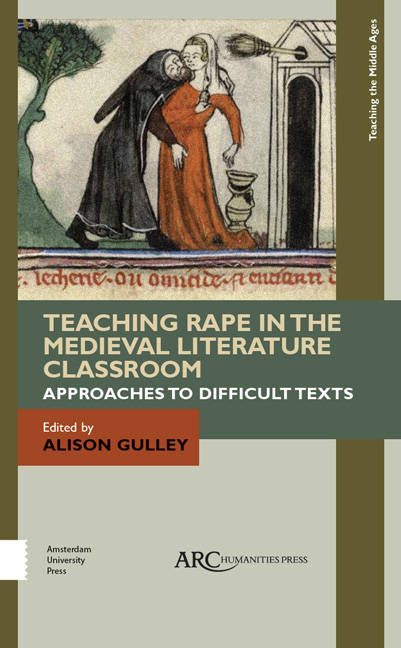Book contents
- Frontmatter
- Contents
- Acknowledgements
- Chapter 1 Introduction: Teaching Rape and Meeting the Challenges of the TwentyFirstCentury Classroom
- Chapter 2 Medieval Saints and Misogynist Times: Transhistorical Perspectives on Sexual Violence in the Undergraduate Classroom
- Chapter 3 Teaching Medieval Rape Culture across Genre: Insights from Victimology
- Chapter 4 Bringing the Bystander into the Humanities Classroom: Reading Ancient, Patristic, and Medieval Texts on the Continuum of Violence
- Chapter 5 From Bystander to Upstander: Reading the Nibelungenlied to Resist Rape Culture
- Chapter 6 Speech, Silence, and Teaching Chaucer’s Rapes
- Chapter 7 Classroom PSA: Values, Law, and Ethics in “The Reeve’s Tale”
- Chapter 8 “How do we know he really raped her?”: Using the BBC Canterbury Tales to Confront Student Skepticism towards the Wife of Bath
- Chapter 9 Teaching the Potiphar’s Wife Motif in Marie de France’s Lanval
- Chapter 10 Sexual Compulsion and Sexual Violence in the Lais of Marie de France
- Chapter 11 Troubadour Lyric, Fin’amors, and Rape Culture
- Chapter 12 The Knight Coerced: Two Cases of Raped Men in Chivalric Romance
- Chapter 13 Teaching Rape to the HeMan Woman Haters Club: Chrétien de Troyes at a Military School
- Chapter 14 Rape, Identity, and Redemption: Teaching “Sir Gowther” in the Community College Classroom
- Notes on Contributors
- Index
Chapter 9 - Teaching the Potiphar’s Wife Motif in Marie de France’s Lanval
Published online by Cambridge University Press: 23 January 2021
- Frontmatter
- Contents
- Acknowledgements
- Chapter 1 Introduction: Teaching Rape and Meeting the Challenges of the TwentyFirstCentury Classroom
- Chapter 2 Medieval Saints and Misogynist Times: Transhistorical Perspectives on Sexual Violence in the Undergraduate Classroom
- Chapter 3 Teaching Medieval Rape Culture across Genre: Insights from Victimology
- Chapter 4 Bringing the Bystander into the Humanities Classroom: Reading Ancient, Patristic, and Medieval Texts on the Continuum of Violence
- Chapter 5 From Bystander to Upstander: Reading the Nibelungenlied to Resist Rape Culture
- Chapter 6 Speech, Silence, and Teaching Chaucer’s Rapes
- Chapter 7 Classroom PSA: Values, Law, and Ethics in “The Reeve’s Tale”
- Chapter 8 “How do we know he really raped her?”: Using the BBC Canterbury Tales to Confront Student Skepticism towards the Wife of Bath
- Chapter 9 Teaching the Potiphar’s Wife Motif in Marie de France’s Lanval
- Chapter 10 Sexual Compulsion and Sexual Violence in the Lais of Marie de France
- Chapter 11 Troubadour Lyric, Fin’amors, and Rape Culture
- Chapter 12 The Knight Coerced: Two Cases of Raped Men in Chivalric Romance
- Chapter 13 Teaching Rape to the HeMan Woman Haters Club: Chrétien de Troyes at a Military School
- Chapter 14 Rape, Identity, and Redemption: Teaching “Sir Gowther” in the Community College Classroom
- Notes on Contributors
- Index
Summary
The midtwentiethcentury folklore scholar Stith Thompson lists motif K2111 as “Potiphar's Wife” and describes it as follows: “A woman makes vain overtures to a man and then accuses him of attempting to force her.” This motif is very widely known, appearing not just in Genesis and the Koran (where it derives its name), but in ancient texts from across the world. It remains a mainstay of Western storytelling, appearing in narratives as disparate as Alexandre Dumas's The Three Musketeers, Harper Lee's To Kill a Mockingbird, and Gillian Flynn's Gone Girl. Less entertainingly, it also appears whenever the subject of acquaintance rape is discussed in the American media. To some segment of the populace, it is both possible and likely that women who accuse men of rape are doing so out of vengeful motivations— and this perception has been apparently validated by such highprofile cases as the Tawana Brawley case in 1987, the Duke lacrosse case in 2006, and the story published by Rolling Stone in 2014 under the title “A Rape on Campus.”
The academic study of literature has largely moved beyond simply identifying motifs in narrative, yet the popularity of websites like TVtropes.org suggests that ordinary audiences still find this form of analysis useful and accessible. In this essay, I will suggest that the analysis of motifs should still be a tool for medievalists in the classroom. Reading and analyzing Marie de France's Lanval in the light of literary motifs can help our students examine elements of American rape culture. Central to the plot of Lanval is the queen's false accusation that the male protagonist has made sexual advances to her— a charge which is patently unbelievable not only to the audience of the poem, but also to the other characters in the story. In the context of literary study, the queen's accusations take on a more violent subtext, reflecting the Potiphar's Wife motif. My central suggestion in this essay is that the motif reflects one way of making sense of a real epistemological dilemma. Moreover, I will argue that this motif performs a certain sort of cultural work, allowing readers to enter into a fantasy inversion of normal gendered power dynamics that allows true allegations to be safely ignored or discredited.
- Type
- Chapter
- Information
- Teaching Rape in the Medieval Literature ClassroomApproaches to Difficult Texts, pp. 128 - 137Publisher: Amsterdam University PressPrint publication year: 2018
- 1
- Cited by



